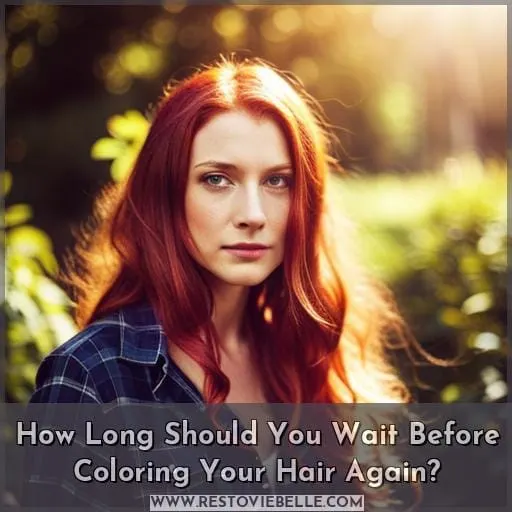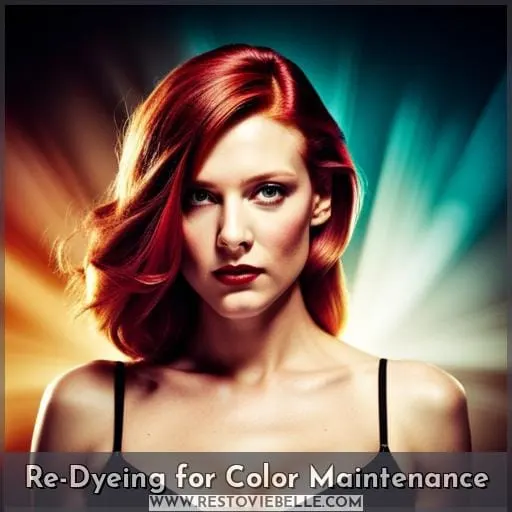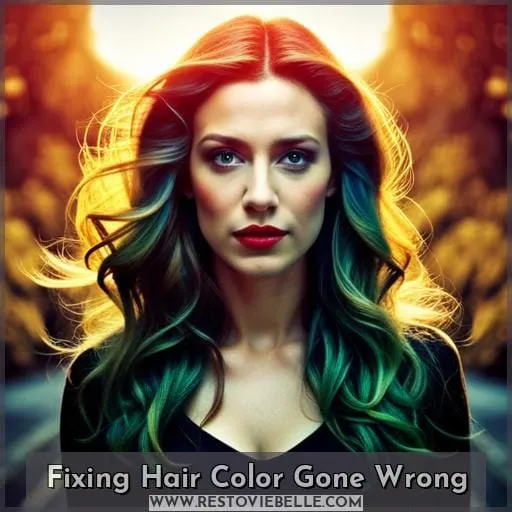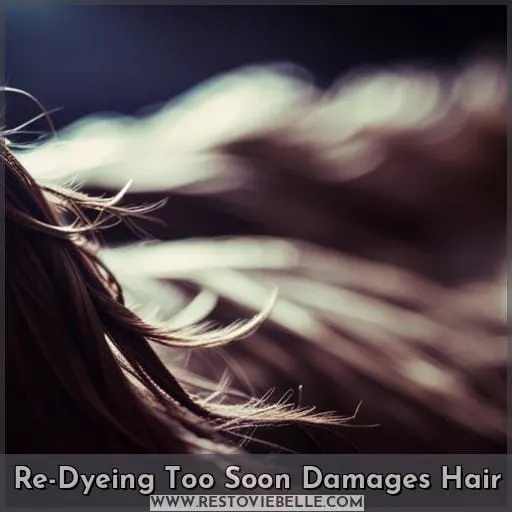This site is supported by our readers. We may earn a commission, at no cost to you, if you purchase through links.
 You’re eager to get back to that fresh-from-the-salon feeling. We understand – new hair is exciting! However, before you race to redo your ‘do, pause. Hair needs a rest between chemical services. Allowing about 4-6 weeks enables your strands to recuperate.
You’re eager to get back to that fresh-from-the-salon feeling. We understand – new hair is exciting! However, before you race to redo your ‘do, pause. Hair needs a rest between chemical services. Allowing about 4-6 weeks enables your strands to recuperate.
Dyeing too frequently can likely cause damage – dry, brittle locks may lose their natural luster. We want your color looking flawless, not fried! Be patient and give your mane time to recover. Then, you can revive your hue, knowing your hair is healthy. Your color will thank you for the break.
Table Of Contents
Key Takeaways
- Wait 4-6 weeks between chemical hair services for healthier hair.
- The timing for touch-ups depends on your hair type: fine hair (4-5 weeks), medium hair (5-6 weeks), and coarse hair (6-8 weeks).
- Different types of hair dyes have varying wait times: permanent (2 weeks), semi-permanent (1 week), and temporary (no wait).
- To avoid damage and maintain hair health, consult a stylist for personalized advice on coloring frequency and products.
How Often Can You Dye Your Hair?
Before coloring your hair again, consider the damage prevention, hair health, and type of dye variables. The proper wait time between colorings reduces potential harm to your strands. Choosing more temporary dyes allows for more frequent touch-ups.
Damage Prevention
You can significantly limit any damage from hair coloring by carefully considering timing between dye jobs and choosing lower maintenance options.
- Wait at least 2 weeks between permanent coloring.
- Use semi-permanent dyes more frequently.
- Consider highlights instead of full color.
- Use Olaplex or bond-building treatments.
Healthy dyeing habits will promote hair recovery and prevent overuse damage. Prioritizing hair condition with strategic timing and less damaging options can help maintain vibrant color while preventing harm.
Hair Health
Along with avoiding damage, you’ll want to factor in recommended wait times between coloring sessions depending on your hair type and the dye you’re using. Semi-permanent dyes only require about a week between applications, while permanent dyes need 2-4 weeks for your hair to recover.
Consider your hair’s health and growth rate too. Frequent dyeing can lead to brittle, dry hair over time. Space out permanent dye jobs by a month or so to maintain hair health. For touch-ups with semi-permanent dyes, aim for every 2-3 weeks.
Type of Dye
Having covered the importance of giving your hair time to rest and recover between coloring treatments based on the health needs of your particular hair, let’s drill into how often you can safely re-dye based on the type of coloring product you’re using.
Semi-permanent dyes require just a week between applications and last 4-12 washes.
Demi-permanent dyes need two weeks between applications, lasting up to 24 washes.
Permanent dyes require the longest wait, two weeks, but provide the longest-lasting color, 4-6 weeks.
More temporary dyes allow for more frequent re-dyeing but don’t provide as durable results.
Consult a stylist to determine the right coloring frequency and products for your hair goals and needs.
Wait Times by Dye Type
Different types of hair dye require different wait times between coloring treatments. Permanent hair dyes typically need you to wait at least 2 weeks before re-dyeing, while semi-permanent dyes only require about 1 week.
Temporary dyes don’t damage hair much, so you usually don’t need to wait at all between uses.
Permanent Dye
Looking at specific permanent dye options, you’ll need to wait at least two weeks before re-coloring if you’ve used permanent dye or bleached your hair. Permanent dyes last 4-6 weeks but must be reapplied frequently. However, fast redying risks damage like dry, brittle hair.
For long term maintenance, see a hair specialist about lower-damage options. With permanent dye, wait two weeks minimum before another application.
For bad permanent dye jobs, correction takes patience – wait two weeks then try clarifying shampoo or bleach.
Semi-Permanent Dye
You should wait one week before re-dyeing your hair with semi-permanent dye. It causes minimal damage and lasts 4-12 shampoos. As semi-permanent color fades and washes out over time, you can refresh your hair color more frequently.
Semi-permanent dyes contain low levels of developer and no ammonia, avoiding cuticle penetration for less hair damage.
The pigments coat the hair shaft and wash out gradually, allowing for reapplication in 7-10 days. When refreshing your color, assess the fading and how long your desired tone lasted previously to determine optimal timing.
With semi-permanent dye, you can re-dye in a week for maintenance and to keep your color vibrant.
Temporary Dye
If you are coloring after using temporary dye, the recommended wait times before re-dyeing depend on the type you used:
- Color-depositing conditioner: You can re-dye immediately since it only lasts 5-10 shampoos.
- Temporary root concealer: Wait 1-3 days before re-dyeing.
- Temporary hair mascara: Allow 1-2 days before re-applying dye.
- Temporary hair spray: No waiting time is needed since it lasts just 1 shampoo.
- Temporary colored mousse: Wait 1 day before re-dyeing.
Re-Dyeing for Color Maintenance
For maintaining your preferred hair color, you’ll want to schedule a touch-up with your stylist every 4-6 weeks, depending on your hair’s growth rate and personal preferences.
Hair Type Recommended Touch-Up Frequency Reasoning
Fine 4-5 weeks Fine hair shows roots faster as it tends to be
low density
Medium 5-6 weeks Most common hair type, medium density and
texture
Coarse 6-8 weeks Coarser hair growth is less noticeable between
touch-ups
How often you need a color refresh depends on factors like your natural hair color and how quickly it grows out, along with the shade you wish to maintain. Darker permanent hair dyes tend to fade more slowly than lighter colors. Semi-permanent options fade out more quickly since the dye sits on top of the hair cuticle rather than penetrating it.
Your stylist can help determine the ideal timeline for maintaining your preferred color results through regular salon touch-ups.
Fixing Hair Color Gone Wrong
If your new hair color turned out too brassy or blacker than expected, don’t panic. Give your hair some time to recover before attempting to fix it. Wait at least two weeks after dying your hair before using color removers, bleach, or toners to correct issues like unwanted brassiness or an uneven black dye job.
Correcting Brassiness
Correcting brassiness in your hair color is easily fixed in 2-3 days by toning it back to your desired shade. Brassiness occurs when hair lightens unevenly, leaving yellow or orange tones. Use a semi-permanent toner or gloss to counteract brassiness between full colorings.
Purple shampoo helps but won’t fully correct brassiness alone. For significant brassiness, seek professional help for an overall toner or color correction. They can assess your hair and select the right product and level of toning. To maintain toning at home, use a weekly semi-permanent gloss or toning mask.
Clarifying shampoos strip product buildup, so avoid overuse. With the right toning products and techniques, you can fix brassiness in just a few days.
Black Hair Dye Issues
If you’re unhappy with your new jet black hair, you can try washing it a few times with a clarifying shampoo or consider having it bleached by a professional after waiting at least two weeks.
Black hair dye often has issues with improper application leading to an uneven result. The permanent nature of the dye along with potential scalp reactivity can cause hair breakage and damage.
If you were trying to cover greys, the black dye may fade unevenly and unmask them again. Hair color removers and hair stripping can help but should be handled by a professional due to the potential for patchy results and further damage.
Re-Dyeing Too Soon Damages Hair
You’re risking permanent damage like dry, frizzy, and brittle hair if you re-dye too soon.
- Wait at least 2 weeks before permanent hair dye touch-ups to give your hair cuticle time to close and restore.
- Allow 1 week between semi-permanent or demi-permanent dye jobs. These have less damage but still require some recovery time.
- Use temporary or depositing conditioners more frequently since they have minimal damage.
Over-processing causes hair texture changes. Brittle, frizzy hair occurs when the cuticle can’t close properly. Allow proper time between chemical processes. Discuss maintenance schedules with your stylist to avoid unnecessary damage from re-dyeing too soon.
They can suggest lower maintenance options if you want less frequent touch-ups. Be patient and let your hair rest between coloring for best results.
Can You Dye Hair Twice in One Day?
Despite wanting immediate results, double-dyeing your hair in one day can lead to severe damage like dryness, brittleness, and breakage. It’s a common misconception that a second round of dye will fix any issues, but this approach often causes more harm than good.
Here’s why:
Firstly, applying dye twice in a single day puts immense stress on your hair. The chemicals in hair dye, especially in the case of hair bleach, can strip away your hair’s natural oils and moisture, leaving it parched and vulnerable.
This rapid coloring can lead to dryness, making your hair prone to split ends and breakage.
Secondly, the risk of user error increases significantly when double-dyeing. Achieving an even color on the first try can be tricky, and attempting it again in the same day can result in uneven, patchy, or undesired tones.
Lastly, the potential for hair loss is a real concern. Excessive coloring in a short timeframe can weaken hair follicles, leading to hair loss issues. It’s crucial to exercise patience and give your hair the time it needs to recover between coloring sessions.
Instead of double-dyeing in a day, consult with a professional stylist for better results and to protect the health of your hair.
Consider Lower Maintenance Options
If you’re looking to reduce the frequency of hair coloring and minimize potential damage, consider lower-maintenance options. Temporary dyes are a great choice as they cause less damage and can be used more frequently since they fade over time.
Additionally, it’s wise to space out your permanent hair dye treatments to prevent overexposure. Consulting with a stylist can help you determine the best approach based on your hair type, needs, and desires.
Temporary Dyes Cause Less Damage
Considering lower-maintenance options is essential when aiming to minimize the damage caused by frequent hair coloring.
- Temporary Dye Benefits: These dyes cause less damage as they do not penetrate the hair shaft deeply.
- Quick Fixes: Temporary dyes can be a quick solution for color touch-ups without the commitment.
- Dye Frequency: You can use temporary dyes more frequently, allowing you to experiment without long-term consequences.
Space Out Permanent Treatments
To space out permanent treatments and explore lower maintenance options, assess your coloring needs and preferences carefully. Consider the natural rate of hair color fade, and consult a stylist for expert advice.
If you’re concerned about gray coverage, discuss it with your stylist to find suitable solutions. Remember that permanent hair dye requires more frequent touch-ups, typically every 6-8 weeks for color maintenance.
Opt for semi-permanent or temporary dyes if you desire a lower maintenance routine and more flexibility in color change.
Consult With A Stylist
If you have questions or concerns about your hair coloring regimen, consult with a stylist to explore lower-maintenance options. Your stylist’s expert recommendations and color expertise can provide valuable insights into achieving the look you desire while minimizing the impact on your hair’s health.
They can suggest color-safe shampoos, advise on the best timing for touch-ups, and help you avoid color clashes. Trust in their professional advice and let their color vision guide your hair journey.
Consult Your Stylist on Timing
Now, let’s move on to how you can determine the ideal timing for your hair coloring with the help of your stylist. Your stylist is your best resource for personalized advice when it comes to coloring your hair.
They can provide you with recommendations tailored to your unique needs and preferences.
When consulting your stylist on timing, consider factors like your natural hair type, including its color, growth rate, and the desired color you want to achieve.
Your stylist can help you choose the most suitable hair color option that aligns with these factors. They can also provide guidance on lower maintenance options if you prefer a less frequent touch-up schedule.
Additionally, your stylist can discuss the ideal coloring frequency with you. While general guidelines suggest touch-ups every four to six weeks, this can vary based on your specific hair and preferences.
Some individuals may prefer a more temporary dye that causes less damage but doesn’t last as long, while others may opt for a permanent color that requires more frequent maintenance.
In the end, remember that your stylist is there to help you make the best choices for your hair. By consulting them on timing and considering their recommendations, you can ensure that your hair coloring experience is both satisfying and aligned with your individual needs and desires.
Conclusion
To put it simply, your hair is like a delicate canvas, and the paint you choose can either enhance its beauty or cause damage.
When it comes to the question of how long you should wait before coloring your hair again, the answer depends on several factors. Waiting times vary based on the type of dye you use, and they play a crucial role in preserving your hair’s health.
If you want to avoid damage and maintain vibrant hair, remember the key rule: patience is your ally.
-
Damage Prevention: Waiting at least two weeks before re-dyeing your hair is essential. This pause allows your hair to recover from any potential damage caused by the previous coloring session. Rushing into a new dye job can lead to dry, frizzy, and brittle hair.
-
Type of Dye: Different dyes come with distinct wait times. Semi-permanent and demi-permanent dyes require one to two weeks before re-application, as they have less damage potential. On the other hand, permanent dyes and hair bleach also need a two-week break but can cause medium to high damage.
-
Re-Dyeing for Color Maintenance: If you’re aiming to maintain your hair color, stylists recommend touch-ups every four to six weeks. The frequency may vary based on your preferences and the type of dye used. Temporary dyes, while causing less damage, may need more frequent re-application.
-
Fixing Hair Color Gone Wrong: If you’re not satisfied with your hair color or encounter issues like brassiness or uneven black dye, remember that patience is your best friend. Give it a couple of weeks before attempting corrections, and for tricky cases, consult a professional.
-
Re-Dyeing Too Soon Damages Hair: Repeating the coloring process too quickly can lead to permanent damage. Overzealous dyeing can compromise the health of your hair, making it essential to adhere to recommended wait times.
-
Can You Dye Hair Twice in One Day? The answer is a resounding no. Dyeing your hair twice in one day is a risky move that can result in extra damage. It’s best to space out your coloring sessions for the sake of your hair’s well-being.
In summary, the key to vibrant, healthy hair lies in understanding how long you should wait before coloring your hair again. Patience, adherence to recommended wait times, and careful consideration of dye type are your allies in the quest for beautiful and damage-free hair.
So, whether you’re maintaining your color or correcting a mistake, always remember to give your hair the time it needs.












